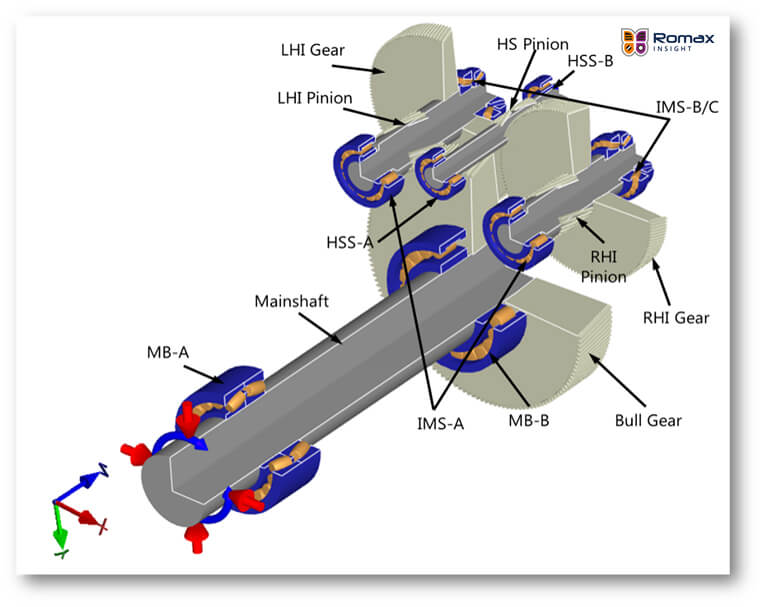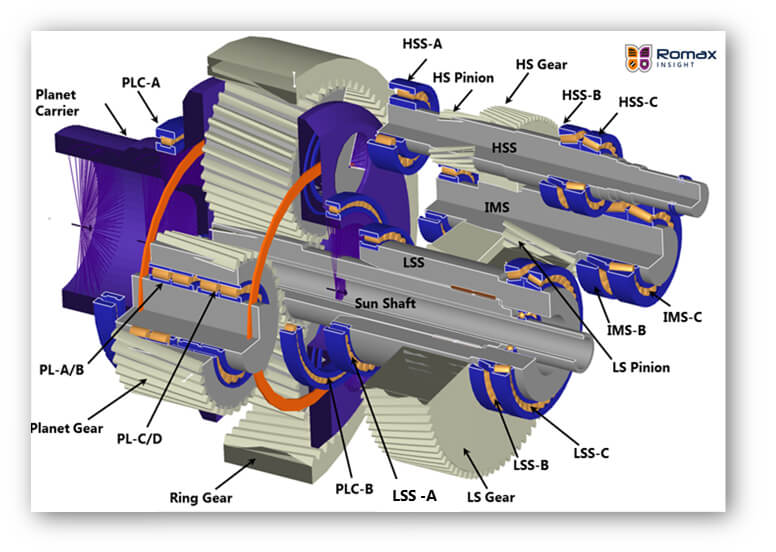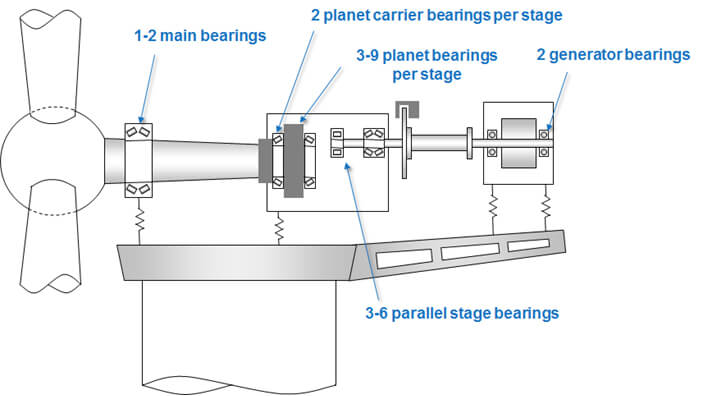By Dr. John Coultate, Head of Engineering Development
& Mike Hornemann, Reliability Engineer
Romax InSight

A blast from the past. Here is an example of a 2-parallel stage gearbox design, typical of a mid-1990’s wind turbine.
As utility-scale wind turbines have developed from the kilowatt-class to the multi-megawatt machines installed today, the components inside a nacelle have also evolved to keep up with new power demands.
Drivetrains, in particular, have had to change significantly to meet stronger, more variable wind loads and higher power levels — and without significant increases in costs. So, engineers took on the challenge and manufacturers delivered.
What was once an off-the-shelf, industrial gearbox is now uniquely designed to meet the harsh conditions typical of a multi-megawatt turbine. A modern geared turbine typically has a 3-stage gearbox with a low-speed planetary stage and two parallel stages. By using planetary gears, designers created high-powered gearboxes that are durable enough to withstand harsh loading, yet compact enough to maintain a reasonable nacelle size.
This gearbox design has also proven economical for turbines with power ratings between 500 kW and 2.5 MW. However, longevity is the one challenge still unmet in the wind-turbine gearbox industry. Turbine gearboxes are typically given a design life of 20 years, but few make it past the 10-year mark.
Why the discrepancy? Part of the answer is in the way that gear and bearing lives are defined. The life of a gearbox component is stochastic, not deterministic. This means that it is impossible to predict with accuracy when a component will fail, even though it is possible to estimate the probability given certain parameters.

A modern-day design. This 3-stage (planetary / parallel / parallel) design is common to more recent gearboxes.
Keep in mind that wind-turbine drivetrains undergo severe and variable transient loading during start-ups, shutdowns, emergency stops, and grid connections. A turbine’s loading depends on its location in the wind farm and the terrain. Load cases that result in torque reversals may be particularly damaging to bearings because rollers may skid during the sudden relocation of the loaded zone. Micropitting, a form of surface fatigue, is one example of damage in bearings that can affect its longevity.
The life of a bearing is generally defined as the ‘L10’ life, which is the duration after which 10% of the bearings will fail. If L10 for one bearing is 20 years, then there is a 10% chance that the bearing will fail in less than 20 years. This is important because it forces manufacturers and wind operators to think about “lifetime” in terms of probabilities.
It is also important to consider that a wind turbine has more than one bearing. A typical drivetrain has 20 to 25 bearings, including the main bearings, gearbox, and generator bearings. So, what happens if we combine the L10 life for every bearing in a drivetrain to calculate a “system-level life?” A simple calculation for a drivetrain with 25 bearings, all with an L10 design life of 20 years, indicates that the probability of one or more bearings failing within 20 years is 93%.

A typical wind-turbine contains 20 to 25 bearings, all of which must be considered in a system-level reliability calculation of life expectancy.
Based on this calculation, nearly all gearboxes in a wind farm are likely to fail within 20 years. This may seem shocking, but it is a reality in the field. Many wind operators will attest that most gearboxes have been changed or gone through an up-tower repair of some kind, such as a new high-speed stage shaft or bearings, long before its 20-year life is up.
Now let’s ask how many gearboxes will fail within seven years? The same calculation indicates that the probability of one or more bearings failing within seven years is 37%. This means more than one-third of gearboxes will suffer some sort of bearing failure.
These results come from a simplified calculation and are only intended to show overall trends, but they show some startling findings. Unfortunately, the calculation can under-estimate gearbox failure rates because it fails to account for non-fatigue failure modes. But the good news is that, in practice, some bearings offer a design life in excess of 20 years because their size is dictated by other factors, such as stiffness or safety factors during extreme load cases.
This is why the term “design life” is misleading, and one reason why many gearboxes in the field are failing in less than 20 years. One way to mitigate these failures is to employ more reliable engineering methods throughout the entire lifetime of a turbine. For example, using design standards and simulations, along with reliable operational data and historical failure rates, it is possible to provide accurate predictions of drivetrain failures.
This article was part of our 2018 Renewable Energy Guidebook. View the full publication here.
Filed Under: Gearboxes, News, O&M





Appears the torque of the wind turbine blades exceed the durability of the bearings. Plus its a variable load too. I bet the North Dakota wind and temperature extremes increase the longevity of these high tech wind mills.
I’ve heard power is produced 30% of the time and the unit has to be shut down at high wind velocities and low temps. Is this true and would you provide me the facts for turbines being constructed in my area. Can you obtain wind power from other areas transfer it to areas where the wind and/or temp is limiting wind power production. Otherwise do you rely on fossil fuel power production to fill in the gap for the power grid need. Thanks.